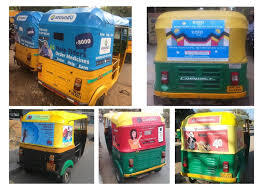
Auto Advertising refers to the practice of using three-wheeled vehicles commonly used for short-distance transport, especially in South Asia . These vehicles are often wrapped in full or partial advertisements or carry signs and banners to promote products, services, or brands. This type of Auto advertising is effective in urban areas where they are a popular mode of transportation and Branding frequently navigate through crowded streets, increasing exposure to a wide range of people.
There are different types of auto advertising:
Full Wraps: The entire surface of the auto rickshaw is covered in an advertisement, making it highly visible and eye-catching.
Side Panels: Advertisements are placed on the sides of the rickshaw, which are visible to people on the streets, especially in busy areas.
Back Panel: The rear panel of the auto rickshaw often features an advertisement that is visible to people behind the vehicle while it is in traffic.
Seat Back Advertising: Ads are placed on the back of the driver’s seat, so passengers who ride in the rickshaw are exposed to the ad.
Taxi Top Signage: Like traditional taxis, auto rickshaws may carry advertisements on the roof or top signage.
Auto advertisement offers several advantages:
High visibility: Given the high foot traffic in urban areas and the mobility of the rickshaw, ads get a lot of exposure.
Targeted reach: Ads can target specific geographic areas or commuter demographics.
Cost-effective: Compared to traditional forms of advertisement like billboards or television commercials, auto advertising can be more affordable.
Engagement: As rickshaws are often used for short trips, the exposure tends to be concentrated and more frequent, making the ad more memorable for people who see it regularly.
This form of advertisement has become particularly popular in countries like India, Pakistan, Thailand, and other South Asian nations where auto rickshaws are ubiquitous and serve as a critical part of the transportation infrastructure.
